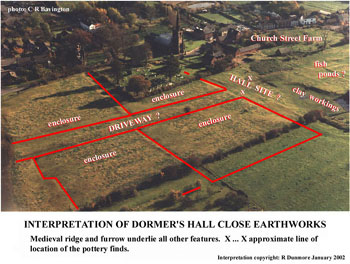Appleby History > In Focus > 11 - Dormer's Hall
Chapter 11
Dormer's Hall
by Richard Dunmore
I have referred previously to the mysterious Dormer family. Isuggested that they came to occupy part of the land owned by Burton Abbey in earlier times and that before their arrival, the Abbey grange farm buildings probably lay where the Dormers came to build their residence, Dormer’s Hall (1). This is my attempt to unravel their story.
An Historical, Agricultural and Topographical Puzzle!
Many people must have strolled across the field behind the Church Hall and wondered about the strange earthworks which lie there. Most obviously, as you enter the field, there is a large excavation, long since grassed over, with a pond near its furthest point. But either side of this, to north and south, the field has ridges and ditches of different sizes and orientations, some of them overlying or cutting across others and all of them now grassed over in the pasture. To explain this curious topography, we need to look closely at the evidence on the ground and then search for information in historical records.
The Detailed Evidence on the Ground
(Click images for larger views)
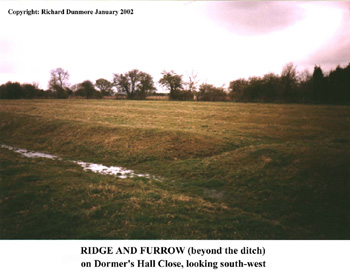 |
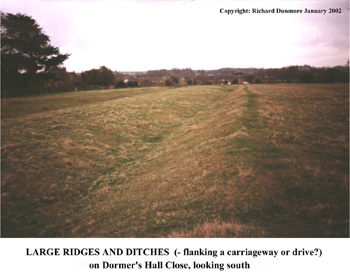 |
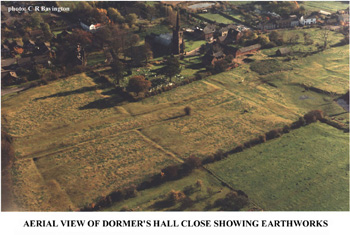 |
The north-west quarter of the field (towards the modern Rectory) shows ridge-and-furrow strips (ie ‘lands’ or ‘londs’), running roughly north-south and these appear to be the oldest earthwork preserved in the pasture as the other disturbances cut across them. These ridge and furrow strips are a remnant of the medieval system of agriculture in which farming land was organised in Open Fields (2).
Dominating the northern half of the field are two unusually large ridges and ditches.
These run at a shallow angle to the ridge-and-furrow and linked to them are other ditches running at right-angles, cutting across the ridge-and-furrow (see aerial view).
Any hedges which grew on the banks must have been removed and the ridges and ditches returned to pasture without being levelled. But a hawthorn bush, possibly a hedgerow remnant, survived on one of the long north-south banks until recently (1999) and is clearly visible in the centre of the aerial view. This system of larger banks and ditches appears to have formed a long enclosure with two squarer enclosures on each side. The size and shape of these, suggest a road or carriageway flanked by four small roughly rectangular paddocks (see Interpretation diagram below).
The excavated area with the pond cuts into the earlier earthworks. This is the type of hollow left by clay extraction for brick-making. Other banks, ditches and irregular earthworks on the southern half of the modern field, towards Bowleys Lane, may include fish ponds (see interpretation diagram). Church Street Farm house and buildings, the National School (now the Church Hall) and the new burial ground clearly have been taken from the original field at a late stage. None of their boundaries conforms to earlier alignments.
Written Records
Medieval ridge-and-furrow was preserved when arable land was put down to pasture, often as late as the 18th century Parliamentary Enclosures. But this particular land must have been enclosed and most of the earthworks ‘fossilised’ in pasture before the Appleby Enclosures of 1772. This becomes clear from Nichols(1811), who gives us its name:
‘A close, Westward from the church, is called Dormer’s Hall Close , from the family of Dormer2 long resident at Appleby. Dormer’s Hall, and the manor-house of Little Appleby, were pulled down about the year 1770.’
Footnote 2: ‘Euseby Dormer died in 1730.’
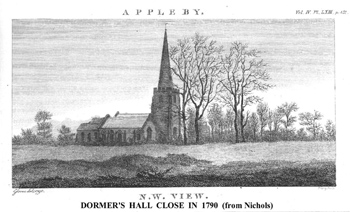 Nichols also has a NW view of Appleby Church seen across Dormer’s Hall Close, drawn by Appleby schoolmaster and reputable artist John Glover, and dated 1790 (picture opposite). In the foreground may be seen two ridges with some growth of shrubs on them, perhaps the remnants of grubbed out hedges. I am inclined to believe that the artist was recording what was actually there, but we cannot really know how much artist’s licence he used in composing his picture (3).
Nichols also has a NW view of Appleby Church seen across Dormer’s Hall Close, drawn by Appleby schoolmaster and reputable artist John Glover, and dated 1790 (picture opposite). In the foreground may be seen two ridges with some growth of shrubs on them, perhaps the remnants of grubbed out hedges. I am inclined to believe that the artist was recording what was actually there, but we cannot really know how much artist’s licence he used in composing his picture (3).
Appleby Parish Registershave Dormerentries from 1653 to 1696 with the name Euseby Dormeroccurring over several generations (4). One of these was a Founder Governor of Sir John Moore’s School from 1699 to his death about 1729 (5). Euseby Dormer was clearly a ‘gentleman’ of some standing in the district, as were all the School Governors. Where did the Dormers come from? A Pedigree of Dormer shows the family in Quainton in Buckinghamshire in the 16th and 17th Centuries (6). Euseby Dormer baptised 14th May 1618 was the fourth son of Sir Fleetwood Dormer of Lee Grange, Quainton who had married Mary, daughter of Sir Euseby Isham of Pytchley, Northamptonshire. So that explains his unusual name.
Nothing further is given about Euseby Dormer I, but his early adulthood coincided with active Parliamentary service in the English Civil War (see below). The first references to the name Dormer in the Appleby Parish Registers occur in the period immediately following:
1653 - Mr Dormor’s man, Robert, bur. Nov. 20
1653/54 - Francis d. of Mr Usabie Darmor bap. Jan. 14
1655 - Ann d. of Mr Usabe & Mrs Susana Darmor bap. May 26
1657 - Eusebie [II] s. of Eusebie & Susanna Dormer bap. Dec. 16
Mr Euseby Dormer of these entries must be Euseby Dormer I, born in Quainton in 1618. Marriage may have been delayed by military service, as he was 35 years old when his first child was born in January 1654. When Euseby II (b.1657) grew up, he and his wife Mary had their own children baptised at Appleby Church: Mary 1681; Elisabeth 1683; Euseby [III] 1684; John 1685 and Rebeckah 1687. Children were also buried: Francis 1695and Crihteon 1696; as was Mr Dormer’s man William Maw in 1686.
It will be seen that Euseby III was baptised in 1684. We have no further register records of the Dormers (there are deficiencies in the Appleby parish registers in the early 18th century). The Governor of Appleby School from 1699 must have been Euseby Dormer II, who would have been 71 or 72 years old when he died about 1729. His death is noted in the School Governors’ Minutes (7) but not in the parish registers; and Nichols has 1730 (see above). There are no other Dormers in the burial registers but Nichols notes the presence of their tombs in Appleby Parish Church:
‘MONUMENTAL INSCRIPTIONS ...Near this [i.e. in the de Appleby Chapel] were also some altar-tombs of the Dormers11, several years since leveled with the floor, on some new pews being put up; and the tomb-stones (on which the inscriptions still remain) are now hidden under the pews ....’ Footnote 11 reads: ‘The name of “Phenwick Dormer” occurs in the School Register, 1710. The Dormers went from hence into Ireland’ (8).
The Origin of the Dormer’s Estate
It seems very probable that the Dormers’ land had originally formed part of the estate of Appleby Magna Manor. The de Appleby Chapel of the Church (now the organ chamber and vestries) was owned and maintained by the Lords of the Manor of Appleby Magna. The fact that the Dormers were allowed to bury their dead in the de Appleby chapel points to a close link between their estate and the manor.
Peter Foss tells us that in 1605 ‘a large estate at Appleby Magna’ was purchased by the second Sir Wolstan Dixie for £550, to pay the income of the master of the newly re-founded school at Market Bosworth. Sir Wolstan’s father also bought ‘the manor of Appleby Magna’, gave it to his son, who then gave it to Bosworth School. The Bosworth Governors became Lords of the Manor (9). The Lordship remained with them until Nichols’ time (c.1800) and indeed later. A 1785 Map of the Appleby Magna Lordship, prepared for the Bosworth Governors, shows the manor land in detail, much of it on the north-west side of the parish (10).
This manor land of 1785, comprising only 228 acres, is fragmented and must represent the Bosworth School allocation from the 1772 Enclosure Award. A farm of 228 acres was far too small to be the whole of the Dixies’ dual endowment of Bosworth School; none of the ‘ancient’ enclosures west of the Church were included. The two parts of the original school endowment must have become separated again. How could this have happened?
A Dubious Dixie
Peter Foss and Timothy Parryhave shown that for much of its life Bosworth School was effectively under the direct control of the Dixies since they appointed the trustees as well as the local Rector (11). Foss has also described how in 1656, during the Commonwealth period, the Royalist (third) Wolstan Dixie was accused by the Puritan chaplain of Bosworth School of misusing the school endowments: ‘He was accused of using the revenues from the rich Appleby estates for his own benefit, obtaining the school seal and thereby giving leases under value to his own kindred’. The case, which was heard before Major-General Whalley, ended in a compromise in which the schoolmasters’ salaries were paid, debts satisfied and all further rents and revenues from the school lands were to go solely to the churchwardens (12).
The evidence of Appleby parish registers shows that Euseby Dormer I was already in the parish by 1653. Alan Roberts has found that Euseby Dormer was a Puritan and ex-Parliamentary Captain of dragoons in the Civil War (13). How did he obtain a sizeable estate at Appleby Magna, without doubt some of the land with which the Dixies, fervent Royalist supporters, had endowed Bosworth School? Had it been sequestrated by the Parliamentarians? Were Dormer and Dixie related? Whatever the explanation, Euseby Dormer had acquired a sizeable estate. The irregularity of the acquisition is apparent from the fact that, much later, his grandson’s right to the estate appears to have been challenged.
London Letters
Euseby Dormer II the Governor of Appleby School, and later his son Euseby III, were both involved in the City of London as were some of the Moores with whom they kept in touch. Clearly, by this date, any ill-feeling towards the Dormers arising from their intrusion into the village had been overcome. Indeed, they were useful to the Moores with their common interests in the City. Surviving Moore Letters between Appleby and London, dated between 1695 and 1740, show business relations with Mr Dormer and imply that heis in London e.g. ‘Pray let me know if Mr Dormer will be down ...’ (14). Clearly, the 1740 reference detailed below must be to Euseby Dormer III (his father had died about 1729):
7 March 1740, George Moore to his brother John Moore at South Gate, Middlesex. Near the Chase Side: ‘.... I rejoice with you as one of Mr Dormers principl. Freinds in the Recovery of his Estate, the lords have done him Great honr. & justice. Our Bells rang for joy on ye occasion.’
What was the occasion of Mr Dormer needing to recover his estate and which would cause such rejoicing in Appleby? Sir Wolstan Dixie (1700-1767) the fourth baronet was renowned for engaging ‘in lawsuits against the high and the low’ (15). If, as seems probable, the original acquisition of land at Appleby by the Dormers had contravened the Bosworth school statutes, not to mention the normal rules of land transaction, then one possibility is that the litigious fourth baronet had tried to repossess the Dormer’s estate for Bosworth school or for himself, but he failed. No doubt supported by the Moores in London, Dormer retained his land. Dixie was not a popular man and the local rejoicing would have been heartfelt.
It is of further interest to note that Euseby Dormer II had offered first refusal of his Appleby estate to Sir John Moore in 1695 as endowment for Sir John’s new school at Appleby (16); but, when the School’s endowment was settled on the Governors in 1699, Sir John had in fact purchased land at Upton (17). Dormer was appointed Foundation Governor at Appleby in 1699 and remained so until his death c.1729, although he attended few meetings of the Governors, probably because of his absence in London (5). The implication of George Moore’s 1740 letter quoted above, however, is that the Euseby Dormer III still had the estate in Appleby at that date.
Acquisition by George Moore
Much of this is necessarily conjecture, but it is a fact that George Moore (Lord of the Manor at Appleby Parva from 1725) acquired the freehold of the Dormer’s estate, presumably from Euseby Dormer III on or before the latter’s departure from the village. In his Will, dated 3rd August 1751, George Moore directed as follows:
‘... and I do hereby also Give and devise unto my Nephew the Reverend Mr Thomas Moore (the son of my said Brother Thomas Moore) All that close called Butyard Close together with the Scite of the Messuage lately called Dormors Hall and the Orchard Dovecoat Yard and Dovehouse now late thereto belonging Scituate and being in Great Appleby in the County of Derby ...’ (18).
It is clear from this that George Moore must have acquired the land well before 1751, as the will refers to the site of the Hall, implying that the building was derelict. Nichols says it was demolished about 1770. The materials, especially stone, were a valuable commodity and would have been quarried for use in building projects in hand at the time. In modern terms, the materials were recycled. It would appear that the Moores removed the boundary fences of the small enclosures and turned the land around the Dormer’s Hall site into a single large enclosure some time between the date of George Moore’s will in 1751 and John Glover’s 1790 view of the church across the close (see above), published by Nichols.
Church Street Farm
The land on which Dormer’s Hall had stood became part of Church Street Farm. The 18th century farmhouse and buildings were probably built by the Moores for a new farm following the parliamentary enclosures. George Moore had died unmarried in 1751 and the estate was inherited by his senior nephew Charles Moore (1718-1775) who was a barrister of the Middle Temple in the London Inns of Court. It was during Charles Moore’s period of Lordship that the un-enclosed parts of Appleby Parish were enclosed by Act of Parliament (1771) and the associated Enclosure Award (1772) (19). It can hardly be a coincidence that, at the time of the drafting of the Act of Enclosure, the Lord of the Manor at Appleby Parva was a lawyer. The effect of the enclosures was to enable the consolidation of areas of land into the farms which largely survive today and of which Church Street Farm became one. Although there was wholesale exchange of land across the parish to achieve this, ancient enclosures were left alone. When Charles Moore died in 1775 without children, the Appleby Parva estate passed to his cousin Rev. Thomas Moore (1723-93) the owner of Dormer’s Hall Close since 1751. The old Dormer’s Hall enclosures consequently became part of Church Street Farm and the Dormers’ land, originally part of Appleby Magna manor, remained in the possession of the Moores until the final dispersal of their estate in 1919 (20).
Brick Making
Much of the underlying geology of the parish consists of Triassic layers of Keuper Marl, a mixture of clay and carbonate of lime (21). Marl has been found useful as a fertiliser, hence the many marl pits surviving as ponds in the landscape, but the clay must also have been found suitable for brick-making. Clay workings have destroyed a significant part of the centre of Dormer’s Hall Close. Apart from the physical excavations both here and in nearby fields in Bowleys Lane, the evidence for brick-making is sparse. However, according to the 1841 Census a Brick Kiln Yard was situated in this area (22). The Census enumerator was Edwin Hague the English Master at Appleby School. Examination of his returns shows that he recorded the inhabitants in a very systematic manner, walking round the village from house to house. Golden Way (the modern Rectory Lane) is followed in the census listings by the (Old) Rectory, Butt Yard Cottage and Brick Kiln Yard. Mr Hague called next on James Parker at Church Street Farm and then continued down Church Street. As we have seen from George Moore’s will of 1751, Butt Yard was another name for Dormer’s Hall Close. Butt Yard Cottage, occupied by an agricultural labourer John Walton, must have been the cottage which stood in the corner of the next field on the edge of the excavated area. This was known in later years as Glebe Cottage. The next property recorded, Brick Kiln Yard, had four households including that of George Bates, bricklayers labourer. We may suppose that these cottages were adjacent to Brick Kiln Piece, a small field north of Bowley’s Lane (23). Brick-making had clearly taken place in this area before 1841 and may have provided the bricks for Church Street Farm itself.
The Site of Dormer’s Hall
On the south bank of the clay excavation are the remains of the dovecote (mentioned in George Moore’s will - see above) which is now just a spread of bricks and nettles. This dovecote is clearly marked on 19th century maps (24). Behind the Church Hall yard there is a deep hole filled with rubble, which was possibly a well. The southern portion of the field has depressions which may have been fish-ponds. These are all indications that a house of some stature stood nearby. A comparison may be made with the Moat House site, to the east of the church, which has a fishpond and a dovecote which may still be seen.
Without a proper archaeological investigation and given the disturbance of the area by the clay workings, the site of the Dormers’ residence within the modern field is difficult to pin down. It probably lay close to the east-west footpath. The footpath rises onto a large platform before reaching the further kissing-gate (to the west) and this platform may be the position of a farm building but not necessarily the Hall itself. If the large banks and ditches formed the boundaries of a grand carriageway approach to the house from the north, symmetry would point to the house lying at the eastern end of the clay excavation. Maybe the digging of clay started from the hollow left after the removal of the house materials. Incidentally, apart from the pond and its winter overflow, water does not accumulate in the hollow, suggesting that the eastern part, where the house might have stood, has disturbed ground beneath the surface.
Archaeological Finds
In 1989 I collected a number of pottery fragments from a single shallow furrow, ploughed across the footpath area behind the Church Hall, where the field tenant was burying a water pipe and close to the suggested site of Dormer’s Hall. These artefacts were examined by Peter Liddle of the Leicestershire Museums Identification Service who identified the following (25):
Click images for larger views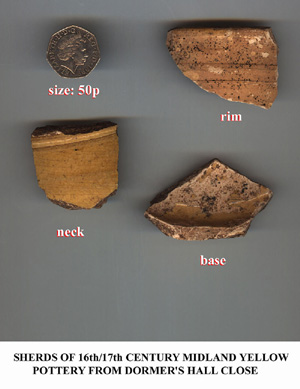 |
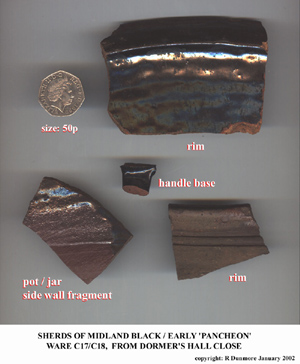 |
[BURTON ABBEY PERIOD:] 1 rim of C12/C13 cooking pot; 1 strap handle from C13 jug (? Nuneaton kilns); 1 handle top and neck of Midland Purple storage jar/ cistern (C15 - C16); 1 turn of base of Midland Purple storage jar/ cistern (C16);
[DORMERS’ PERIOD:] 3 Midland Yellow sherds: 1 rim, 1 base, 1 neck, C16 - C17; 4 sherds of Midland Black/ early “Pancheon” ware, C17 - C18;
[LATER:] 2 sherds “Pancheon” ware, C19; 2 modern sherds; 2 slate fragments; 1 neck fragment of bottle, C18 - C19; 4 fragments of tile, ?C18 - C19.
These indicate almost continuous domestic occupation of the site from the 12th century, if not earlier, to modern times. Burton Abbey had possession of the site from 1004 up to the dissolution in the 16th century. Settled ownership was again achieved by the Dormers from before 1653 until the mid-18th century. Butt Yard Cottage which, with Church Street Farm, was built after Dormer’s Hall was pulled down, survived well into the 20th century.
The Last Phase
In 1845 the National School, for girls and infants, was erected on part of the close opposite the Church. This is now the Church Hall. Finally, in 1877 squire G J Moore gave an acre of land as an additional burial ground (26).
Conclusion
Clearly, the last word has not been said about this intriguing site. The Dormers arrived in the aftermath of the Civil War and stayed for only about 100 years. They built a house, Dormer’s Hall, on the site where Burton Abbey probably had its medieval farmstead. It had a dovecote and possibly fish-ponds. The medieval open-field strips were enclosed to create small rectangular closes flanking a long enclosure, providing a northern approach to the Hall. The Dormers survived a dispute about their right to the property, but by the mid-18th century they had left for a new life in Ireland.
The core of the original manor at Appleby Magna continued to provide endowment income for the Dixies’ School at Market Bosworth while the other ‘half’, the Dormers’ estate, was acquired by George Moore (1688-1751). The site of Dormer’s Hall and its outhouses was robbed for building materials and the land excavated for brick-clay. One of George Moore’s successors, perhaps Revd Thomas Moore (1723-93) who inherited the lordship in 1775, erected the new house and buildings for Church Street Farm in the late 18th century. The Dormers’ enclosures were not required once their Hall had been demolished. Hedges were removed but the banks and ditches were never levelled, leaving the earthworks in the pasture which we see today.
Sources and Notes
[LRO = Leicestershire Record Office; PRO = Public Record Office]
1. In Focus 8 (probable site of Burton Abbey’s ‘grange’)
2. In Focus 9, (‘lands’ in Open Fields)
3. Nichols op. cit. p 431 (demolition of Dormer’s Hall c. 1770). John Glover’s NW View of the Church is on the facing page; for details of Glover see R. Dunmore, This Noble Foundation, Sir John Moore School Trustees, 1992
4. Appleby Magna Parish Registers LRO: 15D55/ 1-11
5. R. Dunmore, This Noble Foundation, op cit, p.142; Eusebie Dormer, School Governor 1699-1729, attended only four out of a possible 28 Governors’ meetings.
6. Pedigree of Dormer of Lee-Grange and Quainton, Buckinghamshire
7. Appleby Grammar School Governor Minutes LRO: DE 2618/1
8. J. Nichols, History and Antiquities of Leicestershire Vol. IV part 2, 1811 (p. 436); the Dormers’ memorial inscriptions may still be under the organ chamber floor.
9. P. Foss, History of Market Bosworth, Sycamore Press, 1983, p 50
10. Map of the Lordship of Appleby Magna Manor, 1785 LRO: DE633/49
11. P. Foss & T. Parry, A Truly Honest Man (Diary of Joseph Moxon), Moxon Family Research Trust, 1998, p2
12. P. Foss, History of Market Bosworth, op.cit. p 63
13. Alan Roberts, Early Modern Villagers 1, part 1 Appleby Gentry (Euseby Dormer captain of dragoons; religious differences with Rector Abraham Mould), see this web-site. Mould, evicted by the Puritans, but reinstated in 1660, was clearly Anglican and Royalist - see J H Pruett, The Parish Clergy under the Later Stuarts, 1978, p 17.
14. Moore Letters, Loughborough Library : Thomas Moore to his uncle Sir John Moore, 1695; George Wait (first headmaster) to John Moore (Sir John’s nephew) 1699; George Moore (son of Thomas, above) to his brother John, 1719, 1721, 1740
15. P. Foss & T. Parry, A Truly Honest Man, op.cit. p 4
16. Letter from George Moore to his uncle Sir John Moore, 18 Sept 1695, LRO DE1642/13
17. R Dunmore, This Noble Foundation, op. cit. p 27 (Upton estate endowment); the proposal to buy an estate at Upton was discussed in correspondence between Sir John’s nephews in Appleby and London in January 1698, LRO DE1642/30
18. Will of George Moore, 3rd August 1751, PRO: Ref. PROB II 789 (bequest of Dormer’s land). The Will of Thomas Moore (1725), PRO: Ref. PROB II 604; George’s father, refers to ‘all that my Mannor or Mannors of Great Appleby and little Appleby in the Countyes of Derby and Leicester’. Although this might suggest that he held the manor of Appleby Magna, this cannot have been true as Bosworth School continued to hold the lordship right through into the 20th century; the School’s map of its lordship is dated 1785 - see note (10) above. It seems likely that Thomas Moore had managed to acquire some land from the fragmented manor, but not its ancient core, nor yet the estate of the Dormers. The sweeping wording of Thomas’s will seems to have been a cover-all expression to describe all his landed possessions.
19. Appleby Enclosure Award, 22 October 1772, LRO: 15D55/ 44
20. Appleby Hall Estate Sale Catalogue, Castiglione & Scott, London, 20 November 1919 (sale of Church Street Farm)
21. Geological Survey of Great Britain, Sheet 155, Atherstone, 1953
22. 1841 Census Appleby Magna, Derbyshire part, Burton on Trent Library
23. Map of the Parish of Great and Little Appleby 1831/32, op.cit, Ref. No. 106; the Brick Kiln Yard cottages must now be No. 30 Bowleys Lane; Brick Kiln Piece is the paddock on which stands the bungalow next door, No. 28
24. 19th Century Maps: Ordnance Survey, various
25. Peter Liddle, Archaeological Report on Dormer’s Hall Site Finds, 1989
26. Kelly’s Directory of Derbyshire, 1895, p.24 (National School and burial ground)
Acknowledgements
The late Mr Clive Bavington for taking the aerial photograph of Dormer’s Hall Close
Mr Howard Brooks of Dandenong, Australia, a descendant of the Dormers, for sending me a copy of the Pedigree of Dormer
Dr Alan Roberts of Adelaide, Australia, for finding the information about Euseby Dormer’s military and religious background in the Civil War (see reference 13)
Miss D L Hale of Swannington for finding the Moore Lettersand the Wills of George and Thomas Moore
©Richard Dunmore, January 2002
Previous article < Appleby's History In Focus > Next article


